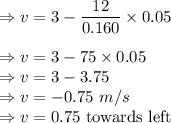
0.160-kg hockey puck is moving on an icy, frictionless, horizontal surface. At t 0, the puck is moving to the right at 3.00 m/s. (a) Calculate the velocity of the puck ( magnitude and direction) after a force of 25.0 N directed to the right has been applied for 0.050 s. (b) If, instead, a force of 12.0 N directed to the left is applied from 0 tot 0.050s, what is the final velocity of the puck

Answers: 3
Another question on Physics

Physics, 21.06.2019 21:50
Acar travels along a highway with a velocity of 24 m/s, west. the car exits the highway; and 4.0 s later, its instantaneous velocity is 16 m/s, 45° north of west. what is the magnitude of the average acceleration of the car during the four-second interval?
Answers: 2

Physics, 22.06.2019 06:00
Which of the following changes will result in a stronger electromagnet? a. using fewer coils of wire b. using a higher voltage c. using a shorter nail d. using a longer wire
Answers: 1

Physics, 22.06.2019 13:20
Ahanging spring stretches by 35.0 cm when an object of mass 450 g is hung on it at rest. in this situation, we define its position as x = 0. the object is pulled down an additional 18.0 cm and released from rest to oscillate without friction. what is its position x at a moment 84.4 s later? express your answer in cm.
Answers: 1

Physics, 22.06.2019 20:20
Consider a file currently consisting of 200 blocks. assume that the file control block (and the index block in the case of indexed allocation) is already in memory. calculate how many disk i/o operations are required for contiguous, linked, and indexed (single-level) allocation strategies, for each of the conditions listed below. in the contiguous-allocation case, assume that there is not room to grow at the beginning but there is room to grow at the end. also assume that the block information to be added is stored in memory.
Answers: 3
You know the right answer?
0.160-kg hockey puck is moving on an icy, frictionless, horizontal surface. At t 0, the puck is movi...
Questions

History, 28.08.2019 20:20









Computers and Technology, 28.08.2019 20:20













 is applied to the right for
is applied to the right for 


 is applied for 0.05s
is applied for 0.05s 



